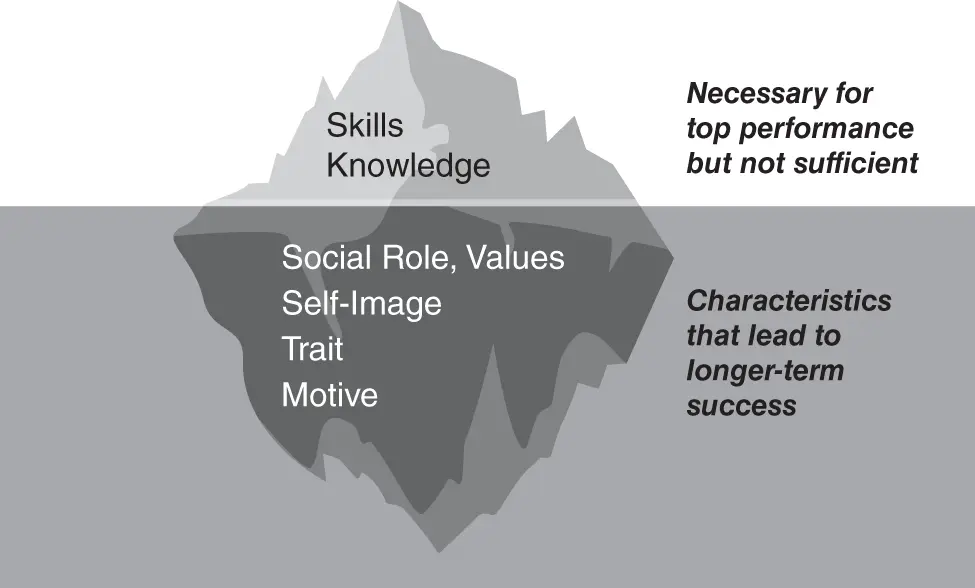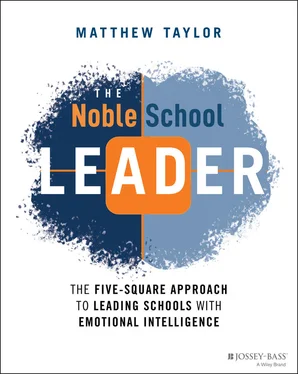When implementers lead from someone else's playbook without connecting to their values, they may inadvertently lose touch with their own visions. Implementers tend to lead from a persona that is not authentic to who they are and to what they believe. They are less likely to truly connect with others, particularly when confronted by adaptive leadership challenges that require authentic influence and inspiration to be able to solve.
Why These Mindsets Matter
These self‐limiting mindsets have a deep impact on the leaders whose behaviors are governed by them. These obstacles lead to constant overwork and significant emotional turmoil that has become known as chronic stress or power stress. In their book Becoming a Resonant Leader, Boyatzis and McKee refer to the cycle of constant stress as the sacrifice syndrome, which ultimately leads to burnout and diminished effectiveness (Boyatzis and McKee 2005). 8 Leaders who can't find their way through these obstacles suffer. They do not live the lives that they imagined for themselves. Further, they will not realize their potential for growth as leaders and human beings, and they know it. While all of this is terrible for the leaders themselves, the negative impact of their self‐limiting mindsets on the people they lead, and their educational outcomes, is much greater. This is because teaching and learning are emotional work, and emotions are contagious.
School Leadership Is Primarily Emotional Work …
In our focus on educational outcomes, we often lose sight of the fact that learning and teaching are fundamentally emotional work. People need to feel emotionally safe to learn. There have been multiple studies showing that emotional connection is a condition for learning:
A concept from graduate school that has stayed with me is Vygotsky's Zone of Proximal Development theory. The idea here is that, for people to learn new skills, a trusted “knowledgeable other” must guide and encourage them as a first step (Penguin Dictionary of Psychology 2009). 9
Research on memory has made it very clear that what makes its way into long‐term memory is almost always associated with a strong emotion (Bloom 1956). 10
Bloom's Taxonomy identifies the affective domain—marked by feeling tone, emotional acceptance, or rejection—as one of three domains for learning. The affective domain is the gateway to learning. If the emotional gates aren't open, learning can't get in. Research on memory makes sense when considering the affective domain. What makes its way into long‐term memory is almost always associated with a strong emotion (Conway, Anderson, and Larsen 1994). 11
Goleman writes that how the brain’s reaction to emotional stimuli shows that negative emotions shut down cognitive function while positive ones both reinforce existing synapse connections and create new neural pathways (Karen 1998). 12
Attachment research shows that connection and trust is a prerequisite to learning for people who have experienced trauma, and that this connection does not come easily (Boyatzis in Coursera). 13
Meeting a human being's needs for connection is a prerequisite to their being able to learn from their teacher. Once a teacher has met their student's need for connection, the work of learning can begin. The second core ingredient then comes into play: challenge. The education sector is much more fluent in the challenge component of learning. Academic rigor is the focus du jour, and as a sector we are making headway on the “what” of academic skills. However, effective challenge in teaching and learning is both a “what” and a “how” endeavor. Effective challenge stimulates intrinsic motivation and energizes a learner to strive to meet their full potential. This is a largely human, emotional endeavor that is inextricably linked to the connection between teacher and student.
This book is grounded in the belief that a school leader's job is to create the conditions for the people in their schools to reach their full potential. The two conditions leaders must create for each individual are connection and challenge. These conditions are emotional conditions. They are necessary for both students and teachers alike because emotions are contagious. If the connection and challenge needs of teachers are not being met, then the teachers will not be able to create the right conditions for students.
… And Emotions Are Contagious
The biggest challenge and opportunity of creating the right conditions for people to learn is that emotions are contagious. Significant and astonishing brain research has proven this to be true. We have what scientists call mirror neurons that react to the emotions of those around us. These neurons dance with each other in our separate heads and hearts. The same research shows that the emotions of the person with the most power in a room are significantly more contagious than those of others (Goleman and Boyatzis 2008). 14
These findings have proven what many already knew: that a school reacts to the emotions of its leader. If a leader struggles to manage chronic stress, then so will everyone else in the school. The leader's emotions and the behaviors connected to them tend to be internalized by other leaders and teachers. That's where the most frightening emotional contagion begins. A classroom of students reacts to the emotional contagion of their teacher. If a teacher is experiencing chronic stress, then so will everyone in their classroom. Consider the impact of this emotional contagion on the conditions for learning.
The science of emotional contagion teaches us that emotional conditions for learning are delicate, tenuous, and very dependent on leaders. This is true from the superintendent all the way down the chain to the teacher. There is a far more powerful and complex emotional interdependence between us than we think that impacts our ability to create emotional conditions. Everyone in a school's emotional chain is responsible for the conditions that actually come to pass. The higher up the leader, the more impact they have on the system and the more responsibility they bear for ensuring that a healthy climate of connection and challenge is present.
We Cannot Teach Mindsets …
To understand why we can't teach new, productive mindsets, we must begin with Daniel Goleman's definition of a competency. According to Goleman, competencies consist of a combination of characteristics that are best described using the analogy of an iceberg. Below the water's surface we know that there is not only more iceberg, but significantly more than what we see above the surface. Leadership competencies are like icebergs in that there are the aspects that we can see in a leader's knowledge, skills, and behaviors, but there is much more to the competency below the surface—inside of the leaders or between them and others—that is not visible. In this book we roughly equate the concept of mindset with what is below the surface of Goleman's competency iceberg ( Figure 1.1).

Figure 1.1: Goleman's competency iceberg.
Source: Goleman's competency iceberg. Goleman Daniel. 1995. Emotional Intelligence: Why It Can Matter More Than IQ (Bantam); but may be property of Korn Ferry consulting.
Unfortunately, we cannot just read books, integrate some sentence starters, or practice some leadership skills to change self‐limiting mindsets and behaviors. The root causes are not knowledge‐ or skill‐based, and the behaviors we see are just the tip of the iceberg of the obstacle. The problems that self‐limiting mindsets cause are invisible to the human eye because they are personal and internal, or as I will refer to them, “below the surface.” What's below the surface may be something inside of me, or it may be something between you and me.
Читать дальше













